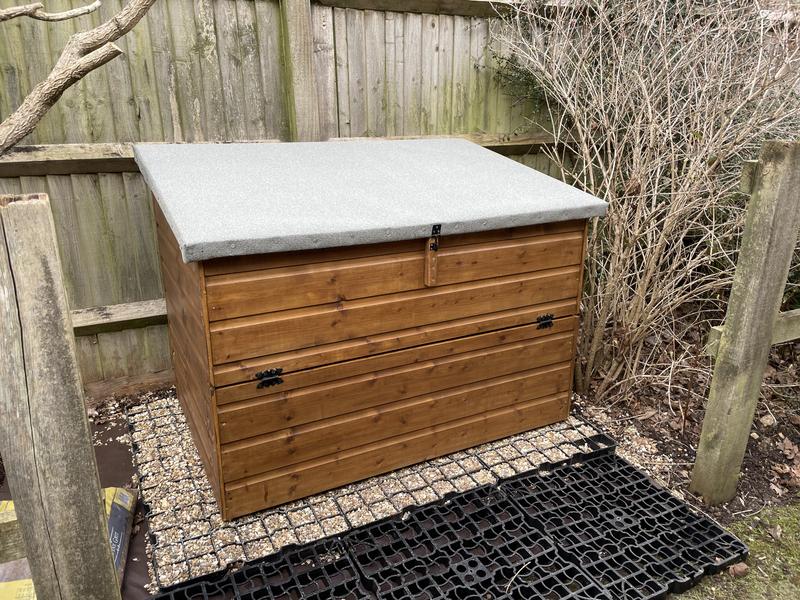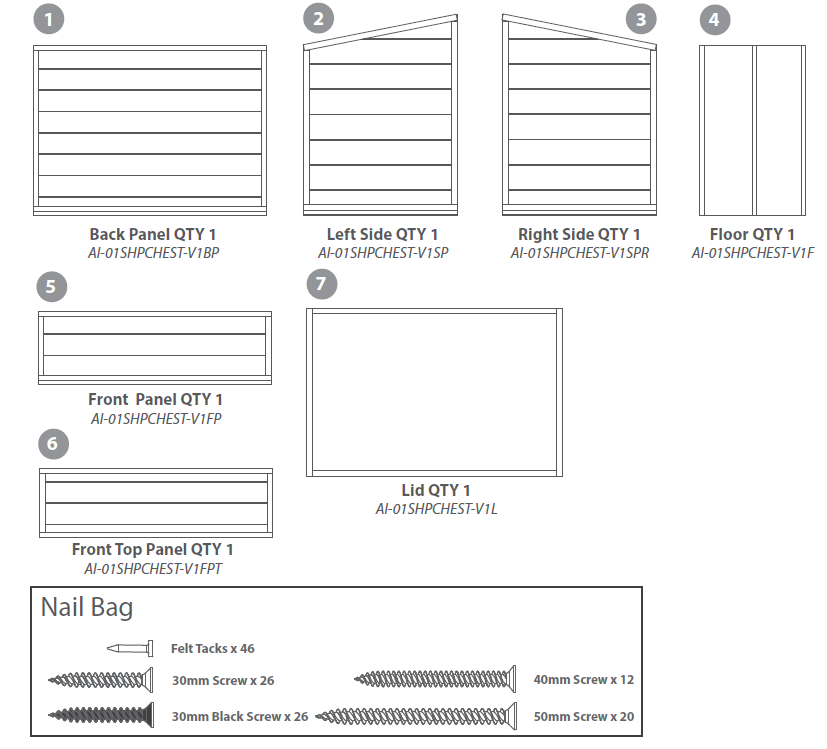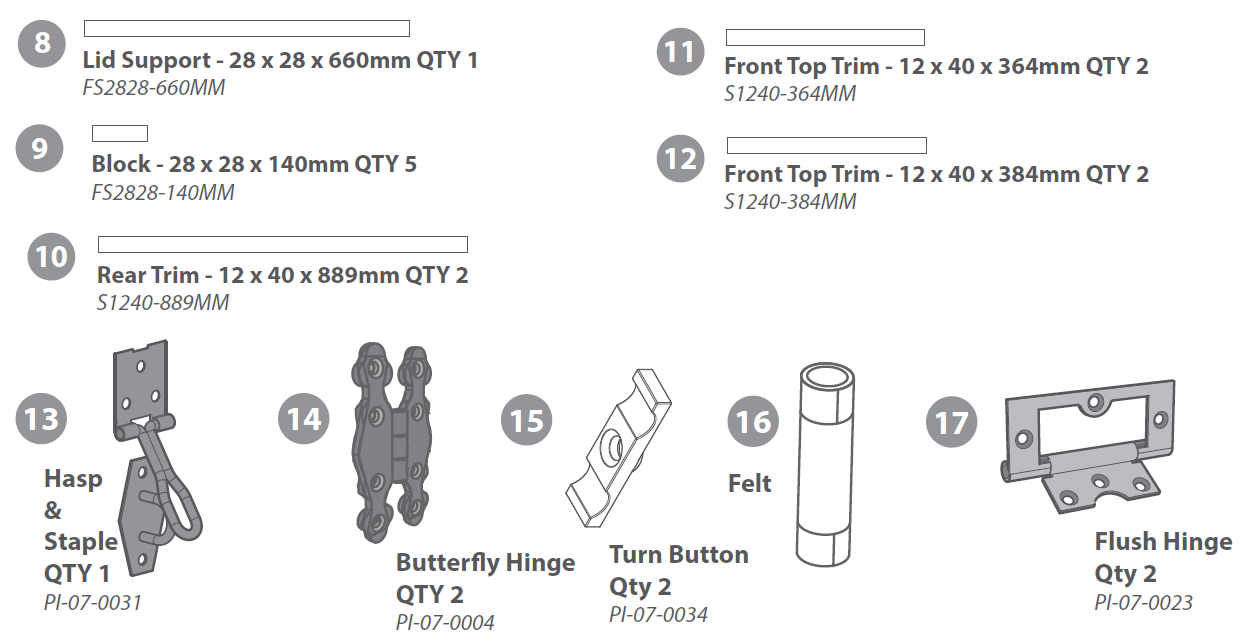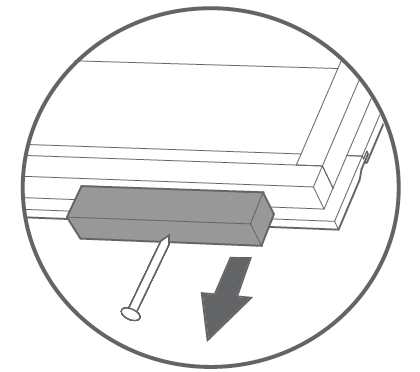Pressure Treated Shiplap Storage Chest
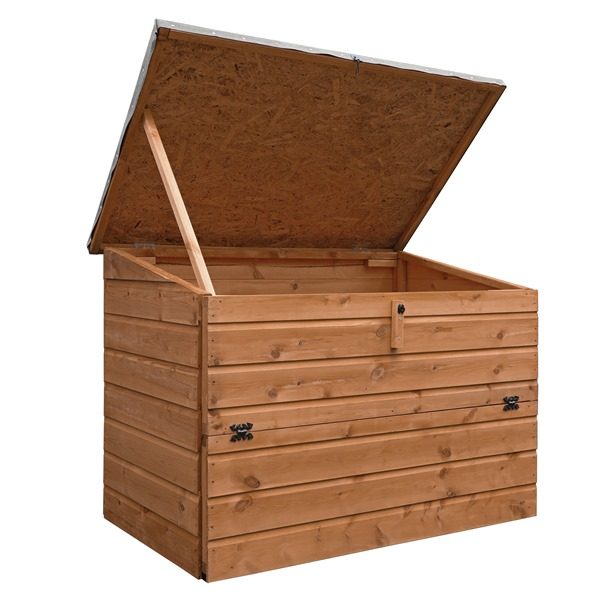
General Instructions
BEFORE YOU START PLEASE READ INSTRUCTIONS CAREFULLY
- Check the pack and make sure you have all the parts listed.
- When you are ready to start, make sure you have the right tools at hand (not supplied) including a Phillips screwdriver, Stanley knife, wood saw, step ladder and drill with 2mm bit.
- Ensure there is plenty of space and a clean dry area for assembly.
TIMBER
As with all natural materials, timber can be affected during various weather conditions. For the duration of heavy or extended periods of rain, swelling of the wood panels may occur. Warping of the wood may also occur during excessive dry spells due to an interior moisture loss. Unfortunately, these processes cannot be avoided but can be helped. It is suggested that the outdoor building is sprayed with water during extended periods of warm sunshine and sheltered as much as possible during rain or snow.
Once your garden building has been installed it will need to be treated as soon as possible and annually to prevent the timber from deteriorating and to waterproof it. This is required to maintain the anti-rot guarantee.Dip Treated buildings – Require a preservative treatment to protect against rot and decay and a waterproof treatment to prevent water ingressPressure Treated buildings – Require a waterproof treatment to prevent water ingressLog Cabins – Are supplied untreated and require a preservative and waterproofing treatment.
BUILDING A BASE
When thinking about where the building and base is going to be constructed:Ensure that there will be access to all sides for maintenance work and annual treatment.
Ensure the base is level and is built on firm ground, to prevent distortion. Refer to diagrams for the base dimensions, The base should be slightly smaller than the external measurement of the building, i.e. The cladding should overlap the base, creating a run off for water. It is also recommended that the floor be at least 25mm above the surrounding ground level to avoid flooding.
TYPES OF BASE
- Concrete 75mm laid on top of 75mm hard-core.
- Slabs laid on 50mm of sharp sand.
Whilst all products manufactured are made to the highest standards of Safety and in the case of children’s products independently tested to EN71 level, we cannot accept responsibility for your safety whilst erecting or using this product.Refer to the instructions pages for you specific product code
- For ease of assembly, you MUST pilot drill all screw holes and ensure all screw heads are countersunk.
- Winter = High Moisture = ExpansionSummer = Low Moisture = Contraction
- CAUTIONEvery effort has been made during the manufacturing process to eliminate the prospect of splinters on rough surfaces of the timber. You are strongly advised to wear gloves when working with or handling rough sawn timber.
Pressure Treated Timber
Pressure treating is a chemical process which helps to protect wood against adverse weather which could lead to rot or insect damage.The most common chemicals used to pressure treat wood are Alkaline Copper Quaternary (ACQ), Copper Azole (CA), and Micronized Copper Quaternary (MCQ).
Safety: Always wear gloves, eye protection and a dust mask when handling wood. Due to chemicals in pressure treated wood, never burn its sawdust or scraps; instead dispose in a landfill.
Overall Dimensions:
- Length = 845mm
- Width = 1285mm
- Height = 920mm
Base Dimensions:
- Length = 1200mm
- Width = 730mm
Box
Fixing Kit
Pre Assembly 
Remove transportation blocks from the bottom of each panel before beginning assembly. Each Panel should have two
Step 1: 
Place the floor on a firm and level base, ensure that the base has suitable drainage, free from areas where standing water can collect. (see front page on base requirements).
Step 2:
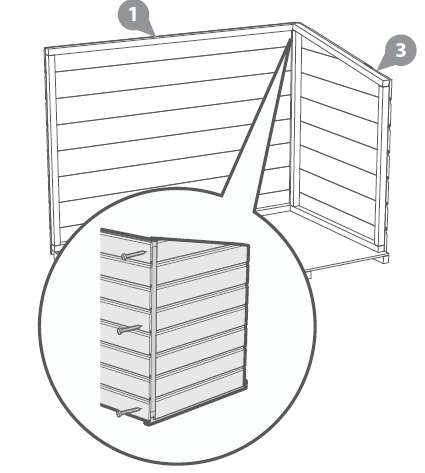
Fix the first side panel to the back panel using 3x50mm screws. Fix the screws from the back panel into the framing of the Side Panels, ensuring the framing is aligned.
Step 3:
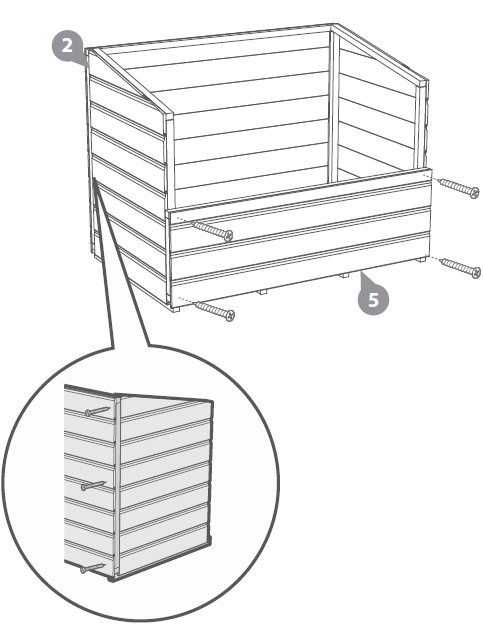
Fix the second side panel to the back panel using 3x50mm screws using the same method outlined in step 2.Attach the front panel using 4x50mm screws as shown in the diagram, ensure to line up the framing.
Step 4:
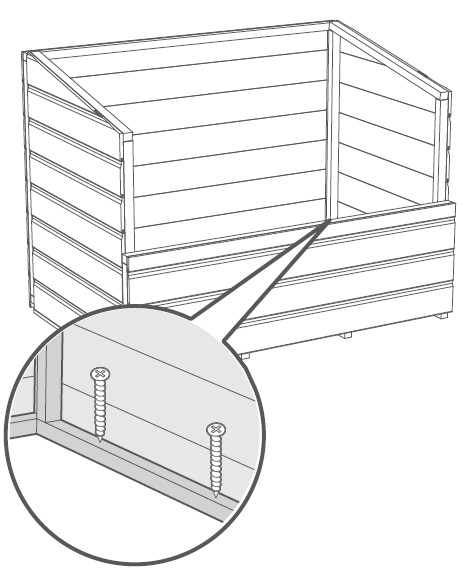
Secure the sides to the floor using 8x50mm screws, making sure to align the screws with the floor joists.
Step 5:
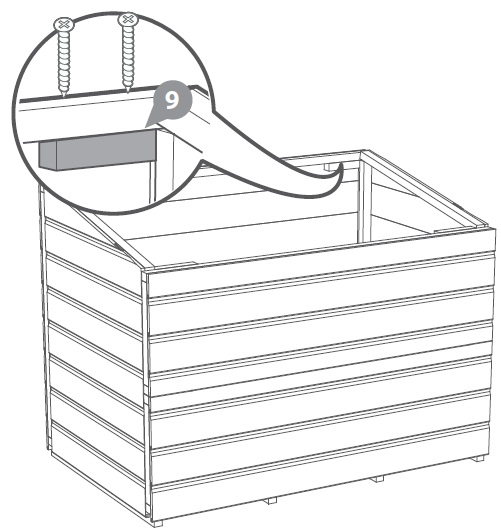
Attach 2 blocks to the Back Panel using 2x40mm screws as shown in the diagram.
Step 6: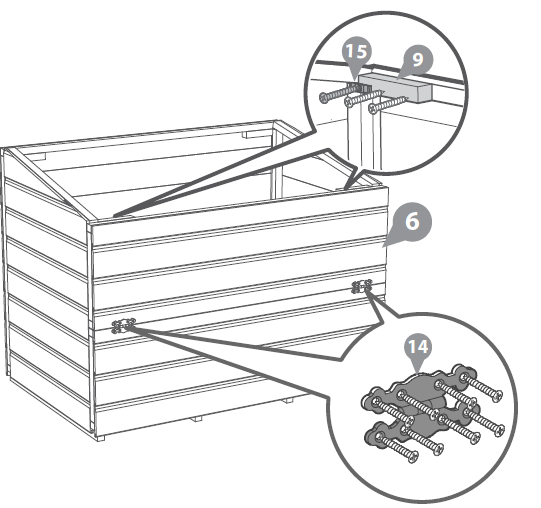
Attach the Front Top Panel using the Butterfly Hinges 8x30mm black screws per hinge.Attach the fixing Blocks to the inside of each corner on the front top panel using 2x40mm screws per block. Then fix a turn button onto each block using a 1x30mm black screw.
Step 7:
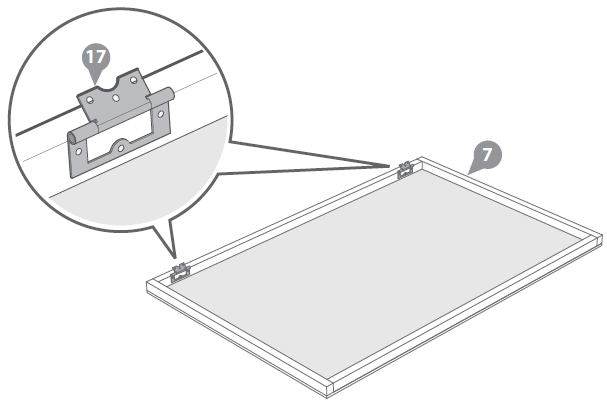
Fix 2 Flush Hinges to the inside of the framing lid using 3x30mm screws.Ensure that the hinge is facing the correct way (see illustration).*Ensure that the hinges are fitted in alignment with the fixing blocks that are attached to the back panel.
Step 8:
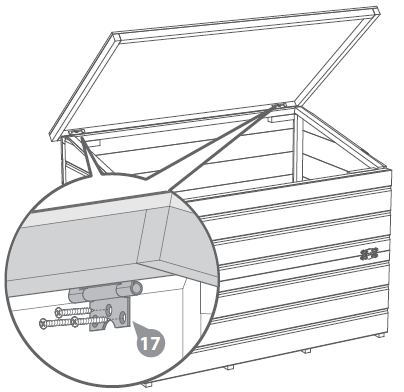
Place the Lid on top of the storage box ensuring that the side panels fit inside the lid and there is enough space to open and close.Then screw the flush hinges into the back panel using 3x40mm screws per hinge. Ensure the screws are fixed into the fixing box on the inside of the chest.
Step 9:
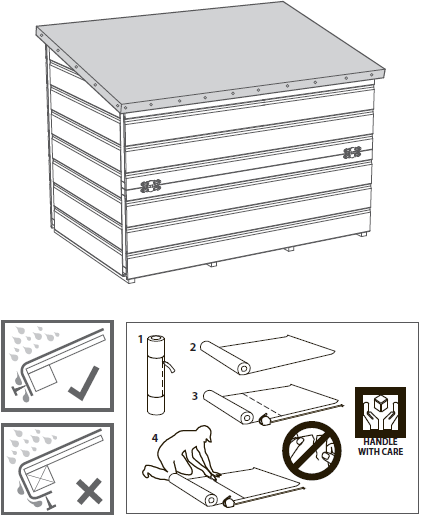
Cut the felt into 1385mm long sheets and lay onto roof as shown in diagram ensuring there is a 50mm overhang on each side then nail the felt tacks every 100mm.
Step 10:
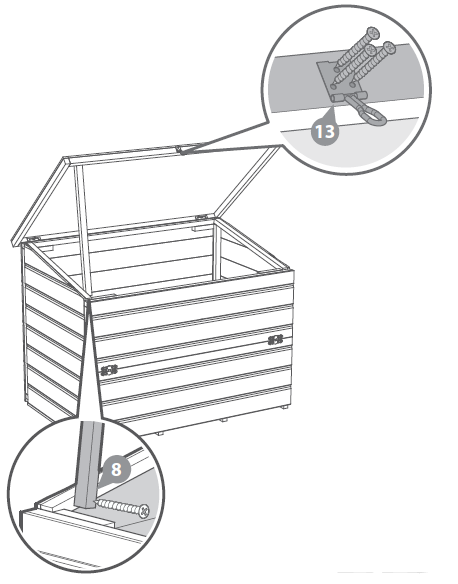
Attach the Hasp to the lid as shown in the illustration wth 3x30mm black screws.Then fix the Lid Support to either side panel using 1x50mm screw. Before fixing ensure that the support frame has space to move up and down without affecting the lid.
Step 11: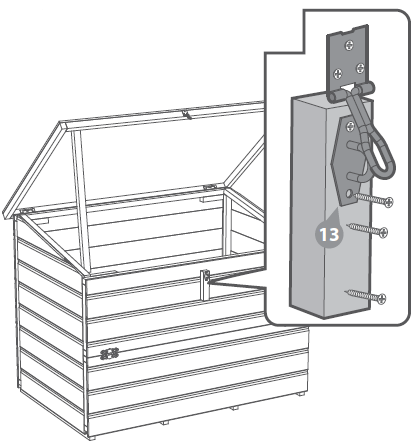
Fix the Staple to the remaining Fixing Block as shown using 2x30mm black screws.Place the Fixing block against the Top Front Panel and line it up with the hasp lock before fixing. and fix with 2x40mm screws.
Step 12:
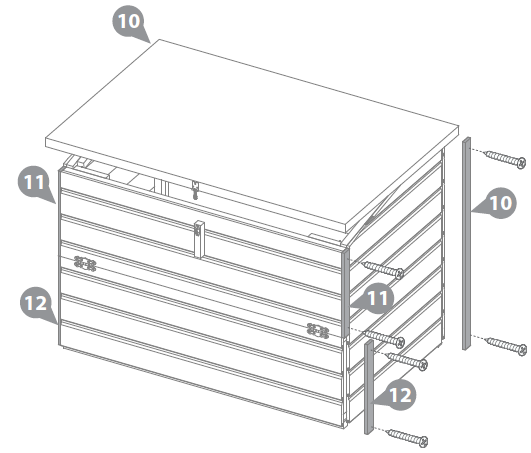
Attach the cover trims using 12x30mm screws as shown in the diagram.
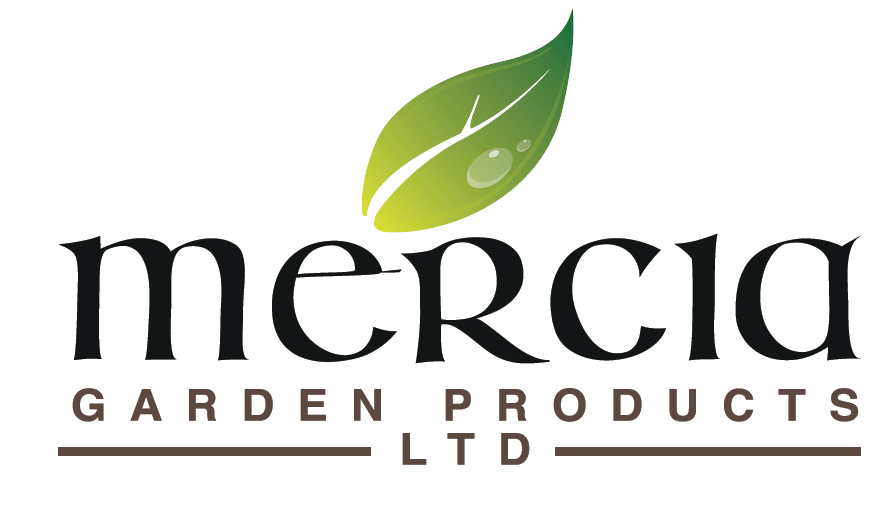
References
[xyz-ips snippet=”download-snippet”]

